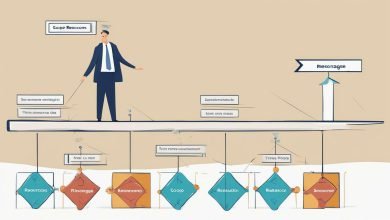
Project management involves the coordination of various aspects to achieve a specific goal. One essential element of project management is stakeholder communications. Effective communication with stakeholders helps to ensure project success by improving collaboration, enhancing efficiency, and facilitating better outcomes.
Stakeholders are individuals or groups who have an interest in the project and can be affected by it. They include investors, sponsors, team members, customers, and suppliers. Communication with stakeholders is critical for understanding their expectations, addressing their concerns, and building strong relationships with them.
Key Takeaways:
- Stakeholder communications are a crucial element in project management.
- Effective communication with stakeholders can enhance collaboration, efficiency, and project outcomes.
- Stakeholders are individuals or groups who have an interest in the project and can be affected by it.
- Communication with stakeholders is critical for understanding their expectations, addressing their concerns, and building strong relationships with them.
The Role of Stakeholder Communications in Project Management
Effective stakeholder communication is an essential element of project management. It plays a vital role in understanding stakeholder expectations, managing their needs and concerns, and building strong relationships with them — all of which are critical for project success.
Stakeholder communications in project management refers to the process of exchanging information between project stakeholders and the project team. It involves a two-way flow of information and requires a thorough understanding of stakeholder communication preferences.
A key aspect of stakeholder communications in project management is managing stakeholder expectations. By communicating regularly and transparently, project managers can ensure that stakeholders understand the project’s progress and goals. This can help to prevent misunderstandings and avoid conflicts that could potentially derail the project.
The Importance of Effective Stakeholder Communications
Effective stakeholder communications are crucial to project success for several reasons. Firstly, effective communications help to improve stakeholder engagement, which is critical to ensuring that all stakeholders are invested in the project’s success. When stakeholders are involved in the project, they are more likely to provide valuable input and support.
Secondly, effective stakeholder communication improves collaboration among stakeholders and the project team. When stakeholders and the project team collaborate well, they can identify and solve problems more efficiently, resulting in a more successful project outcome.
Lastly, effective stakeholder communication helps to build trust between stakeholders and the project team. Trust is essential in project management, as it allows stakeholders to have confidence in the project’s outcome and the project team’s ability to deliver it.
Overall, stakeholder communication is a key element of project management. Effective communication with stakeholders can enhance efficiency, collaboration, and project outcomes, making it critical to project success.
Developing a Communication Strategy for Stakeholder Engagement
Effective stakeholder communications require a well-planned communication strategy that outlines the objectives, audience, channels, and messages. The strategy should be adaptable to meet changing stakeholder needs and expectations. Here are some key steps for developing a communication strategy:
- Identify Stakeholders: Start by identifying all relevant stakeholders and understanding their needs, concerns, and expectations. Categorize the stakeholders based on their level of influence and interest in the project.
- Determine Communication Channels: Choose the appropriate communication channels based on the stakeholder needs and preferences. Consider using a mix of channels, including email, video conferencing, social media, and face-to-face meetings.
- Set Clear Objectives: Define clear communication objectives and outcomes to ensure that all stakeholders are aligned with project goals and expectations. Use key performance indicators (KPIs) to measure the effectiveness of the communication strategy.
- Create a Communication Plan: Develop a communication plan that outlines the frequency and type of communication for each stakeholder group. Tailor the messaging to each group’s needs and interests.
- Establish Feedback Mechanisms: Encourage stakeholders to provide feedback on the communication strategy and adjust it as needed. Use this feedback to continually improve the communication plan and ensure stakeholder engagement.
By following these steps, you can develop a well-rounded communication strategy that meets the needs of your project stakeholders. Remember to remain flexible and adapt your strategy as needed to ensure effective stakeholder engagement and project success.
Implementing Effective Communication Tools and Techniques
In order to enhance stakeholder communications, it is important to implement effective communication tools and techniques. The use of technology can greatly aid communication, as can key communication practices.
Utilize Project Management Software
One effective tool for enhancing stakeholder communications is project management software. This type of software can aid in the organization and dissemination of project information, as well as facilitate collaboration and communication among stakeholders. With project management software, stakeholders can view project timelines, task lists, and progress reports in real-time, which can greatly enhance transparency and ensure everyone is on the same page.
Use Collaborative Platforms
Collaborative platforms, such as Slack and Asana, can also aid in effective stakeholder communications. These platforms allow for easy sharing of project updates, documents, and feedback. They can also facilitate real-time discussions and problem-solving among stakeholders, which can greatly increase efficiency and productivity.
Practice Active Listening
In addition to technology, it is important to practice effective communication techniques when engaging with stakeholders. One key skill is active listening. Active listening involves fully concentrating on what the speaker is saying, asking clarifying questions, and summarizing what was said to ensure understanding. This technique can greatly enhance communication and build trust among stakeholders.
Develop Clear Messaging
Another effective communication technique is developing clear messaging. This involves ensuring that all project communications are concise, easy to understand, and highlight key information. Clear messaging can greatly reduce confusion and misunderstandings among stakeholders and ensure that everyone is on the same page.
Adapt Communication Styles to Different Stakeholders
It is also important to adapt communication styles to different stakeholders. This means understanding the communication preferences and needs of each stakeholder and tailoring communications accordingly. Some stakeholders may prefer formal written communications, while others may prefer more casual face-to-face discussions. Adapting communication styles can greatly enhance stakeholder engagement and build stronger relationships.
By implementing effective communication tools and techniques, stakeholders can greatly enhance their communication practices and build stronger relationships with their stakeholders.
Overcoming Challenges in Stakeholder Communications
Effective stakeholder communication is critical for project success. However, despite the best intentions, challenges can arise that hinder the communication process. Here, we will explore some of the common obstacles that project managers face when communicating with stakeholders and strategies for overcoming them.
Conflicting stakeholder interests
Stakeholders may have different interests, priorities, and expectations. This can lead to conflicts, making it challenging to find common ground. To overcome this challenge, project managers must identify and understand the needs and expectations of each stakeholder, and establish clear communication channels to address their concerns. Effective stakeholder management involves balancing competing priorities and ensuring that all stakeholders feel heard and valued.
Communication barriers
Communication barriers can arise due to cultural differences, language barriers, or lack of understanding. To overcome communication barriers, project managers should adopt a communication strategy that takes into account the cultural and linguistic differences of stakeholders. Using plain language, avoiding jargon and acronyms, and providing translations if necessary can help ensure that stakeholders understand the project goals, objectives, and progress.
Resistance to change
Stakeholders may resist change, particularly if it involves significant changes to their roles, responsibilities, or practices. To overcome resistance to change, project managers should engage stakeholders early and often, involve them in decision-making, and communicate the benefits of the changes. Maintaining transparency and honesty throughout the project can also help build trust and foster a positive attitude towards change.
Effective stakeholder management
Effective stakeholder management involves identifying stakeholders, understanding their needs and expectations, and developing a communication strategy that takes into account their interests and priorities. Project managers must also be proactive in addressing stakeholder concerns and issues, keeping them informed of project progress, and engaging them in decision-making. Building strong relationships with stakeholders requires active listening, clear messaging, and regular communication.
Conclusion
Overcoming challenges in stakeholder communications is essential for project success. By adopting effective communication strategies, identifying stakeholders’ needs and expectations, and building strong relationships, project managers can overcome these obstacles and ensure that all stakeholders are engaged, informed, and invested in the project’s success.
Measuring the Success of Stakeholder Communications
Measuring the success of stakeholder communications is crucial in project management as it helps to determine the effectiveness of the communication strategy. It is essential to identify key performance indicators (KPIs) and metrics that measure stakeholder engagement and satisfaction.
KPIs such as the number of stakeholder meetings held, the number of stakeholders engaged, and the frequency of communication can help in assessing the level of stakeholder engagement. Metrics such as stakeholder feedback and satisfaction surveys can help in identifying areas that require improvement.
Effective stakeholder communication can have a significant impact on project success. When stakeholders feel heard and informed, they are more likely to support the project and provide valuable feedback that can enhance project outcomes. On the other hand, poor stakeholder communication can result in delays, misunderstandings, and resistance to change, which can adversely affect project success.
Therefore, it is essential to regularly evaluate the communication strategy and make necessary adjustments to ensure that stakeholder engagement and satisfaction are maintained at a high level throughout the project lifecycle.
Best Practices for Stakeholder Communications
Effective stakeholder communication is essential for project success. Here are some best practices and tips:
- Identify stakeholders: The first step is to identify all project stakeholders. This includes internal and external stakeholders such as team members, clients, vendors, and partners.
- Establish regular communication channels: Set up regular communication channels to ensure all stakeholders are informed about project progress and any potential changes. This can include weekly status updates, regular meetings, and progress reports.
- Maintain transparency and honesty: Be transparent and honest in all communication. This builds trust and credibility with stakeholders, fostering a positive relationship.
- Adapt communication styles: Adapt your communication style to suit the needs of different stakeholders. For example, use plain language for non-technical stakeholders and more technical language for team members.
- Listen actively: Listen actively to stakeholder concerns and feedback. This demonstrates empathy and understanding, and allows for better problem-solving and conflict resolution.
- Respond promptly: Respond promptly to stakeholder queries and concerns. This shows that their feedback is valued and helps to prevent misunderstandings.
- Manage conflicts: Develop a conflict resolution strategy to manage any stakeholder conflicts that may arise. This helps to maintain positive stakeholder relationships and avoids delays and setbacks.
By following these best practices, project managers can ensure that stakeholder communication is effective and helps to enhance project success.
Conclusion
Effective communication with project stakeholders is vital for achieving project success. In this article, we have explored how stakeholder communications can enhance efficiency, collaboration, and project outcomes. We have discussed the key role of stakeholder communications in managing stakeholder expectations, needs, and concerns and building strong stakeholder relationships.
Developing a communication strategy for stakeholder engagement involves identifying stakeholders, determining communication channels, and setting clear objectives. Effective communication tools and techniques, such as project management software and active listening, can help overcome common challenges in stakeholder communications.
Measuring the success of stakeholder communications can be achieved through key performance indicators and metrics. Consistently applying best practices, such as regular communication channels, transparency, and adapting communication styles to different stakeholders, can enhance effective stakeholder management.
Overall, effective communication with project stakeholders can lead to project success and long-term stakeholder relationships. By adopting the best practices and techniques discussed in this article, project managers can enhance stakeholder communications and achieve project success.
FAQ
Q: What is stakeholder communications?
A: Stakeholder communications refers to the process of effectively exchanging information, feedback, and updates with project stakeholders. It involves understanding their expectations, managing their needs and concerns, and building strong relationships through clear and consistent communication.
Q: Why is stakeholder communications important in project management?
A: Stakeholder communications is crucial in project management because it enhances efficiency, collaboration, and project outcomes. Effective communication allows project managers to understand stakeholder expectations, manage their needs and concerns, and build strong relationships, leading to better project success.
Q: How can I develop a communication strategy for stakeholder engagement?
A: Developing a communication strategy for stakeholder engagement involves several steps. First, identify your stakeholders and prioritize them based on their influence and interest in the project. Then, determine the most effective communication channels to reach them. Finally, set clear objectives for your communication strategy to ensure alignment and effectiveness.
Q: What communication tools and techniques can I use for stakeholder communications?
A: There are various communication tools and techniques that can enhance stakeholder communications. Technology, such as project management software and collaborative platforms, can streamline communication and improve accessibility. Effective communication practices, such as active listening and clear messaging, can also help in building strong relationships with stakeholders.
Q: What challenges can I expect in stakeholder communications and how can I overcome them?
A: Common challenges in stakeholder communications include conflicting stakeholder interests, communication barriers, and resistance to change. To overcome these challenges, it is important to practice effective stakeholder management and conflict resolution strategies. This can involve actively engaging stakeholders, addressing concerns proactively, and fostering open and transparent communication.
Q: How can I measure the success of stakeholder communications?
A: Measuring the success of stakeholder communications can be done through key performance indicators (KPIs) and metrics. These can include factors such as stakeholder satisfaction, timely and accurate information exchange, and the impact of effective communications on overall project success. Regular evaluation and feedback from stakeholders can provide valuable insights for measuring success.
Q: What are some best practices for stakeholder communications?
A: Some best practices for stakeholder communications include establishing regular communication channels, maintaining transparency and honesty, adapting communication styles to different stakeholders, and actively listening to feedback. It is important to create an environment that encourages open dialogue and fosters strong relationships with stakeholders.








